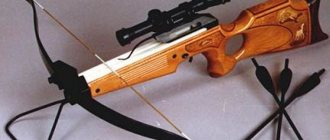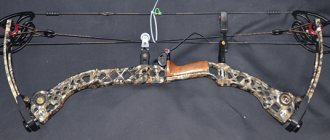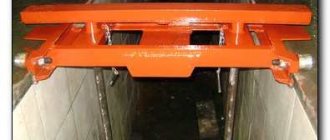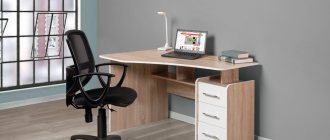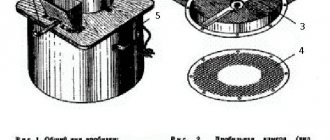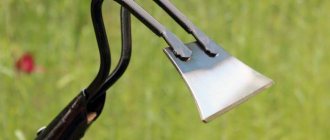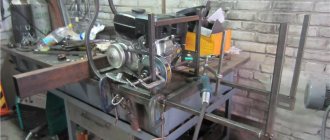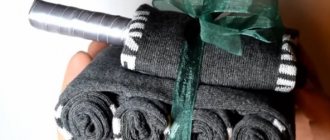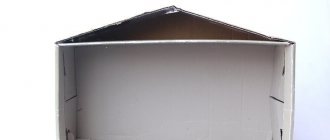The trigger mechanism of revolvers (trigger mechanism) is used to initiate a shot by striking the igniter primer with the striker. There are two types of triggers: trigger and striker-fired. Structurally, a trigger-type trigger can be designed in two ways: either all parts of the trigger are located in a frame, or they are arranged in the form of a separate removable block placed in a frame (Gnome OTs-20 service revolver). The composition of the trigger trigger includes: trigger, firing pin, trigger, mainspring. The trigger serves to transfer the energy of the mainspring to the firing pin when fired.
According to the method of arrangement in the frame, triggers are distinguished: open type; semi-open type; hidden type. Each trigger has a cutout at the bottom, which is called a combat cock, and a knitting needle, with the help of which the trigger is set to a combat cock. Some triggers also have a safety cock. The trigger spoke can be either fixed or folding, for example, in the Mervyn-Gulbert revolver.
Revolvers of the “Velodog” system with open (top) and hidden type triggers.
The trigger mechanism of revolvers (Trigger Mechanism) is single action (SA).
Trigger mechanism of revolvers (trigger mechanism) with self-cocking (DAO).
Double action (DA) trigger mechanism of revolvers.
The striker is used to strike the replacement primer and consists of a rod and a nose, which is called the striker.
According to the method of connection with the trigger, the strikers are: manufactured as a single unit with the trigger, such a trigger has the Tula “Velodog” revolver, the “Manurin” MP, the “Webley-Scott” MK.VI revolver; having a hinged connection with the trigger, for example, the trigger of a Nagan revolver; placed in a frame as an independent part, all modern revolvers have such a striker. The trigger is used to cock the hammer in a double-action trigger and a self-cocking trigger, to keep the hammer cocked, and to decock it.
To keep the hammer cocked there is a special protrusion - the sear. Structurally, they are either non-folding or folding. Folding ones, as a rule, are found in small-sized civilian revolvers of the “Velodog” type. The mainspring serves to transfer accumulated energy to the trigger when compressed to strike the firing pin. According to their design, they can be plate-like or twisted.
They are located either in the handle or in the trigger (OTs-20 “Gnome”). According to the principle of operation, trigger triggers are single or double action and self-cocking. To understand foreign terminology, let us explain: a single-action trigger is called an SA-type trigger (“Single action”); Double action trigger - trigger type DA (“Double action”); A self-cocking trigger is a DAO type (“Double action only”) trigger. The operation of each type of trigger will be described in detail below, when considering specific samples of revolvers. Here we note only the following.
Single-action triggers allow firing only by cocking the hammer before each shot. Early Smith and Wesson and Colt revolvers work on this principle. Among the modern ones we can name the Ruger Blackhawk revolver. Double-action triggers allow you to fire a shot either by cocking the hammer or simply pressing the trigger. All modern revolvers, as a rule, have a double-action trigger.
Read also: How to cut car glass
Revolvers “Decker” (left) and “Dimancha” with a striker-type trigger.
Self-cocking triggers only work when the trigger is pressed. All revolvers with a hidden trigger have a self-cocking trigger. The author knows of striker-type triggers only in two samples: in the Decker and Dimancha revolvers. The trigger mechanism of the Decker revolver includes a trigger with a trigger lever, a rod-type striker and a mainspring. USM works as follows.
When you press the trigger, the lever moves back, cocks and releases the firing pin, i.e. the trigger works self-cocking. The trigger mechanism of the Dimancha revolver includes a trigger, firing pin, star ratchet and mainspring. The USM works as follows. When the trigger is pressed, its sear engages one of the teeth of the star ratchet and turns it. With each rotation, the firing pin is pulled back and compresses the mainspring. In the rear position, the firing pin breaks off the ratchet wheel and a shot occurs. As you can see, here the trigger is also self-cocking.
Do-It-Yourself Shock Trigger Mechanism
USM FOR PSP PISTOL, TRIGGER.
I made a trigger control for an air pistol from trash, more precisely from bicycle spokes, bolts and a 19mm wrench))) HELP WITH A COIN ON THE HP PUMP.
How to make a crossbow trigger / how to make a [email protected]
How to make a crossbow trigger / how to make a [email protected] Friends, almost all of my projects on this channel have enough.
HOW TO MAKE A SHOCK TRIGGER MECHANISM
How to make a trigger on PSP pneumatics. This method is suitable for those who do not have an angle grinder or a suitable sheet of iron. The mechanism works great.
Homemade trigger mechanism. A few words about what I'm going to do in the future.
I apologize in advance for the noise, it’s the system unit that’s making noise (In this video you will see a brief overview of the trigger mechanism. Ask your questions in .
How to make the simplest crossbow trigger.
In this video I would like to show you how I make the simplest and most reliable trigger mechanism for a crossbow made of wood. I've done this once already.
DIY crossbow (part No. 6 Improved trigger mechanism)
In this video I showed how I redesigned my trigger mechanism for a crossbow, watch and comment, it will be a pleasure to read your comments.
IZhK USM debugging
IZhK trigger gun, the trigger is pulled off the combat cock, repairing the trigger with your own hands.
how to make a trigger mechanism for a crossbow drawings
How to make a trigger mechanism for a crossbow, design drawings.
trigger and impact mechanism
Do-it-yourself crossbow trigger (lock) / homemade crossbow trigger
Simple and reliable descender. Very simple and reliable trigger.
How a revolver works 3D diagram
On our channel we publish the latest news from Russia and Ukraine. Video about world events and interesting facts. Subscribe to our.
How to make a crossbow trigger.
https://vk.com/club140287939 - VK Group.
Do-it-yourself revolver made of wood, we make a revolver mechanism from wood, wooden revolver mechanism.
Wooden revolver mechanism In the second part of the video, I make a mechanism for rotating the drum. link to part 2 in .
Homemade spring crossbow: trigger mechanism part.2
I assembled an approximate version from pre-prepared parts for the trigger mechanism, then you need to install the clamps and springs for.
How to make a trigger mechanism (Triggermechanism) for homemade pneumatics (PCP)
DIY PCP air rifle. Part No. 1 USM (trigger mechanism) #PCP #Triggermechanism #shock trigger mechanism.
BOOM. #LITTLE MATCH DERRINGER.#
IN THIS VIDEO, YOU WILL SEE A TINY PISTOL. RESIMBER IN APPEARANCE AND DESIGN OF A Derringer PISTOL.IT IS VERY .
USM + drawings for 1377 and homemade products.
This device is suitable for Crossman1377, as well as for homemade pneumatics. My group on VK https://vk.com/we_love_pneumatics Support the channel.
How to make a crossbow trigger.
https://www.youtube.com/channel/UCu7HaViQkcxJDaXLDrf8dBA Link to our new channel. Move on. #how to do.
Trigger for PSP rifle
Do-it-yourself crossbow. Making the trigger mechanism.
Yes, Yes, Yes)) In principle, the principle is fundamentally clear)) But the principle is basically the same))
How to Make a PCP Trigger
Subscribe to the channel and like if you liked the video. Link to drummer: https://www.youtube.com/watch?v=p9g6IZEumWA.
Do-it-yourself crossbow trigger (lock) / homemade crossbow trigger
Making a trigger for a crossbow with your own hands at home.
How to make PCP pneumatics
Today I will show you how to make a PCP pneumatic with your own hands. This pneumatic gun is enough for 10 shots with one pump! The scheme is much.
Trigger for a homemade PSR rifle
Trigger for a crossbow made of wood.
DIY trigger mechanism (part 2)
How to make a trigger mechanism for a speargun. Part 2.
DIY spearfishing gun. Trigger mechanism for underwater gun (crossbow). Stage 2.
MANUFACTURING A CROSSBOW. TRIGGER MECHANISM. Part 3
Hi all! You are on the Make Destroy channel, here we restore old things and tools, as well as create new ones! Subscribe to the channel .
Hunter's signal of an original design, made with your own hands. Failure number 6.
A hunter's signal of an original design with his own hands, homemade. Description, characteristics.
Almost medieval pistol
A pistol based on the musket principle. CONTINUATION IN VIDEO.
DIY underwater gun, but first, the trigger mechanism.
I immediately made the parts from a 3mm sheet, but then cut out the same ones and welded them with argon welding since there was no suitable thickness initially, but I want it.
Trigger mechanism for slingshot gun part 3
I made a third version of the trigger mechanism for a gun - a slingshot.
Trigger mechanism
Homemade spring crossbow: trigger mechanism
the philosophy of the trigger mechanism, the choice of configuration or how to arrange the critical elements responsible for the correct rotation and.
Crossbows in Rus'
Ancient chronicles about the use of the type of weapon that our ancestors called crossbows provide very contradictory evidence. According to some written sources, the crossbow in the Middle Ages in Rus' was known and used in battles already in the middle of the 13th century. This is confirmed by historical finds dating back to fairly early periods of Russian history. For example, in the ruins of the city of Izyaslavl, which arose in the 12th century and was destroyed by the Mongol-Tatars about a century later, the remains of a warrior were discovered. On his belt there was a special hook for a crossbow bowstring. True, the weapon itself was not found. Therefore, this historical evidence has not been assessed unambiguously.
There are also facts that crossbows appeared in Rus' only in the 14th century. This type of weapon was adopted from the Bulgars during historical military campaigns in those lands of the Russian army.
However, among our ancestors the crossbow cannot be considered one of the particularly popular types of weapons. The explanation for this should be sought in the inconvenience of the design compared to a mobile bow, difficulties in charging, as well as large mass and high cost.
What is makiwara?
A makiwara is a type of sports equipment that essentially performs the functions of a punching bag. Originally, a makiwara was a wooden pole that was dug into the ground and wrapped with rope or straw. Now they have transformed into wall cushions for solo training or soft paws that need to be held by a second partner.
Such equipment is necessary for punching and practicing them. Modern makiwaras can be used to practice punches, elbows, knees and kicks.
What is a makiwara for?
For a novice boxer, a regular punching bag will be enough for training. But those who practice Muay Thai cannot do without this equipment . The need to use this sports equipment is justified for fighters in need of technical progression:
- with the help of paws it becomes possible to practice various combinations and connections . At the same time, accuracy and speed of striking are trained. Similar makiwaras are attached to the forearms. Conditions for safer and more active training are created. A sudden change in position of a sparring partner forces the fighter to change tactics and vector of attack;
- implements that require both hands to hold the handles are commonly used in karate. With their help, kicking techniques are practiced at different heights ;
- Some models are attached to the wall, to another projectile, and you can take them with you. They allow you to practice striking techniques without a partner in any place suitable for training ;
- static makiwara of large size and rectangular shape. The equipment is attached to the wall. It is convenient to practice ligaments with your hands without involving a partner .
The question of choosing in favor of makiwara depends on the training method, on the techniques that need to be practiced. The trainer should suggest which makiwara to use. After all, he selects an individual training program. If an athlete trains independently, he chooses equipment that does not require a partner, at his own discretion.
Ruby pistols
Look
Ruby pistols are self-loading pistols, best known as sidearms of the French Army during World War I, under the name Pistolet Automatique de 7 millim.65 genre "Ruby". Imitating John Browning's pistols, they were produced by more than 50 Spanish firms, but mainly by Gabilondo y Urresti. Pistols like Ruby had intuitive controls, were easy to disassemble and were quickly mastered even by beginners. Its small size and decent magazine capacity made it a popular “backup” weapon for trench warfare, especially for signalmen, orderlies, machine gunners, tank crews, mortarmen and second-line soldiers. The relatively weak cartridge gave a small recoil, which made it possible to better control the weapon and conduct targeted shooting.
History of the origin of makiwara
The projectile received its name back in the 18th century in Japan. Karatekas called this a stack of straw tied with a rope, on which they practiced striking techniques. “Rolled straw” is how makiwara is translated from Japanese.
Over time, the simulator has changed:
- A board tied with straw was dug into the ground. Later, instead of straw, they began to wrap the board with rope in several layers. With the help of such makivaras, hand striking techniques were practiced. With long training, the windings became thinner, and the fighter had to hit a bare board. This indicator was considered the achievement of a certain level of skill. After all, breaking through the soft layer required hundreds of hours of time and powerful force;
- Later, the wrapped board began to be moved. The partner did this to complicate the task;
- makivaras with protrusions appeared, designed to practice the exact trajectory of strikes on a small target.
Over time, makiwaras began to be covered with leather for greater durability.
Beholla self-loading pistol and its variants (Beholla, Stenda, Menta, Leonhardt)
Look
The Beholla pistol was produced between 1915 and 1918 for the German army, in total about 45,000 pistols were produced. Production was carried out in Suhl, from which the pistol got its name (Becker & Hollander). The company was later renamed Stenda Werke and the pistol was named "Stenda". Other German arms companies also produced this pistol; copies are known under the names Menz, Menta, Leonhardt. The Menta and Menz variants, in addition to the 7.65 mm caliber, were also chambered for 6.35 Browning caliber cartridges, which was not the case with the original Behall and Stand.
Do athletes use wooden makiwaras now?
In modern sports, old makiwaras are used by a fairly narrow range of contact martial arts. Wooden exercise machines are suitable for karatekas, as well as adherents of Asian martial arts. They are rarely seen in the hall.
The move away from traditional makivaras is justified by the appearance of pears and bags, on which it is safer and more convenient to practice techniques. A traditional wooden projectile does not have sufficient elasticity to deliver blows, so there is a risk of damage to joints and tendons:
- sclerosis of the wrist bones, muscle microtraumas, arthritis and other joint diseases. This can happen when working for a long time on a makiwara that is not flexible enough;
- bruises and fractures occur in the event of an impact below the soft elastic part of the projectile.
Wooden equipment is used mainly by athletes who like to follow the traditions of their chosen martial art..
BERTIER SYSTEM CARBINE MODEL 1890
Look
In France, instead of the Gra system carbine of the 1874 model, 11 mm caliber, the Berthier system carbine of the 1890 model was adopted. The Berthier system differs sharply from the French infantry rifle of the Lebel system of the 1886 model, firstly, in the magazine, and secondly, in the locking part of the bolt . The Berthier carbine has a barrel length of 450 mm. The caliber is 8 mm, the same cartridge as for the 1886 model infantry rifle. The sight is framed, on a stepped block, has divisions up to 1000 m. The length of the sighting line is 363 mm with the sight down and only 310 mm with the sight up. The length of the carabiner is 945 mm. Weight 3000 g. Among the cavalry models of that time, the French carbine was one of the lightest, most portable and easy to use carbines. Loading the carbine is very convenient at all cavalry gaits; when riding fast, the weapon minimally disturbs the rider, while the carbine, despite the short barrel and very thin at the muzzle, gives satisfactory accuracy of combat.
×
Modern makivaras and their varieties
For different types of strike practice, more relevant makiwaras are used:
- large pillows or paws for pairs activities. With their help, one person holds the equipment, the second hits;
- soft padding that attaches to the wall for independent training;
- wooden Shilov makiwara for single practice of the technique.
Most modern makivaras can easily replace a bag or pear. However, the punching bag will not replace the makiwara when it is necessary to work on the rigidity of the body structure at the moment of impact.
Paws for joint activities
These pillows have the following features:
- form . Rectangular cushions are most common, but there are also round, oval and racket-like makiwaras;
- weight and size . There are small paws for practicing precision strikes, and pads that are used for a wide variety of techniques. These makiwaras are thicker and cover almost the entire leg;
- holding method . The sparring partner must hold the makiwara rackets at arm's length, some pads are held by the handles, or by pressing them against the leg or torso;
- appointment . Small paws and rackets are necessary for practicing combinations of strikes and accuracy, and large pads are used to develop strength, speed, and to train side kicks.
The packing consists of any sealant. The outer part is trimmed with leather or its artificial substitutes.
Wall-mounted makiwaras
The material used for wall-mounted pillows is the same. Sometimes springs are inserted inside for flexibility. On such makiwaras they train technique, like on a boxing bag. The wall-mounted exercise machine is used only for hand striking techniques, since side kicks loosen the fastenings. When struck, the makiwara does not lean back, but the leg simply rests against the projectile or breaks through the wall.
Wall-mounted models also differ in:
- thickness;
- sizes;
- form - a flat mat or a diamond-shaped pillow for delivering side blows and uppercuts.
A protruding wall-mounted makiwara can be an effective replacement for a punching bag for home use.
What kind of crossbow should a beginner shooter buy for recreation?
To choose a crossbow, you need to know that there are two fundamentally different types - recurve and compound crossbow.
Compound crossbows are more compact, they are 20-25% smaller than recurve crossbows, their trigger is very soft, and the take-off speed is higher. This is achieved by the presence of special blocks in the crossbow's shoulders. But they are heavier than recurve ones; replacing the cable (string) is quite difficult, and often impossible in the field.
A recurve crossbow has arms curved towards the direction of the shot, at the end of which there are special fasteners onto which the bowstring is pulled. Their accuracy is high, they are unpretentious in maintenance and repair. You can replace the bowstring yourself without using special tools.
How to make makiwara with your own hands at home?
To make sports equipment you will need:
- polyurethane foam;
- tarpaulin, natural or artificial leather;
- 4 elastic bands with a width of 3 cm and a length of 70 cm;
- Velcro.
Manufacturing sequence:
- Cut several rectangles from polyurethane. Approximate size – 20*30 cm each. These plates will serve as shock absorbers, making training more comfortable and safe.
- Fold tarpaulin or leatherette in several layers to strengthen the surface.
- Place the plates in a column on a tarpaulin or leather and wrap with the material used.
- Make a seam along the post and trim the top and bottom. Soft rectangles should be sewn inside.
- Sew elastic bands one at a time on the four corners of the product. With their help the makiwara will be attached.
- Velcro is sewn along the seams so that when the inner plates wear out, there is no need to sew the product up each time.
Triggers and their parts
Trigger mechanism (trigger mechanism) - a mechanism of small arms, through which the shooter controls the start and end of shooting.
A self-cocking trigger mechanism is a firing mechanism of a small weapon in which the firing mechanism is cocked by pressing the trigger.
A single action trigger is a mechanism in which cocking the hammer by pressing the trigger is not possible.
A double-action trigger mechanism is a mechanism in which, when you press the trigger, both the hammer can be released and it can be cocked.
Fig.1.87.
Single-barrel trigger mechanism
hunting rifle with an external trigger:
1
- firing pin,
2
- firing pin spring,
3
- trigger,
4
- mainspring,
5
- pusher,
6
- trigger spring,
7
- trigger
Fig.1.88. Trigger mechanism of self-loading weapons:
1
- shutter,
2
- drummer,
3
- disconnector,
4
- trigger,
5
- sear,
6
- trigger
Fig.1.89.
Trigger mechanism of a double-barreled hammer-fired hunting rifle:
1
— trigger lever,
2
— trigger lever spring,
3
— hole
for the mounting screw, 4
- combat cylinder,
5
- trigger,
6
- ankle,
7
— mainspring stop,
8
— chain,
9
— trigger spring screw,
10
- two-fingered trigger spring,
11
- stops for safety
mechanism, 12
- triggers,
13
- trigger axis,
14
- hole
with thread for stop screw, 15
- stop and trigger housing,
16
- base
(lower face), 17
- holes for screws securing the base to the receiver,
18
- the triggers themselves (or their shanks),
19
- hole for the screw
fastenings of the tail part of the base. The connecting arrow shows
interacting sections of the trigger (12) and the cocking lever (1)
left barrel mechanism
Schneller is a trigger mechanism in which, with the help of an intermediate lever (levers), the free play of the trigger is reduced and a soft release of the striker is ensured. “Schnell” translated from German means fast, fast.
Trigger part - a part of the trigger mechanism of a small weapon, which is acted upon to fire a shot (depending on the design, they are distinguished: trigger, trigger lever, trigger button, trigger spoke).
A safety guard is a part of a small weapon that protects the trigger from accidental pressing or damage.
The translator is a part of the trigger mechanism of small arms, the impact of which changes the type of shooting.
A sear is a part of a small arms trigger mechanism that holds the firing mechanism or movable automatic system cocked and releases them when the shooter acts on the trigger part.
The trigger rod is an intermediate part between the trigger and the sear, ensuring their kinematic connection.
Fig.1.90.
Schneller trigger mechanism (target small-caliber rifle MTs-12):
1
- bolt striker,
2
- bolt striker cocking,
3
- mainspring,
4
- disconnector,
5
- sear axis,
6
- disconnector tail,
7
- long trigger arm,
8
— spring of the trigger spoke,
9
— cocking of the trigger,
10
— sear of the trigger spoke,
11
— trigger pin,
12
— trigger pin axis,
13
— trigger hammer,
14
— cocker hook,
15
— cocker spring,
16
— cocker axis,
17
- release axis,
18
- release spring,
19
- sear spring,
20
- sear
The disconnector is a part of the trigger mechanism of a small weapon that kinematically separates the trigger part and the sear after a shot.
Combat cock - the surface of the hammer, firing pin, bolt or bolt carrier of a small arms weapon that holds it in the cocked state.
Safety cock - a protrusion of the trigger by which it is held by the sear in a position that prevents it from moving forward without pressing the trigger.
Interceptor (interceptor) - a device designed to intercept the firing pin or hammer that has disengaged from the sear without pressing the trigger. More often found in trigger mechanisms of hunting rifles.
Fig.1.91
. Scheme of operation of the interceptor (interceptor)
trigger of hunting rifles (gun IZH-12):
1
- trigger,
2
- sear,
3
- trigger rod,
4
- trigger,
5
- interceptor;
A
— the moment before the safety protrusion of the trigger enters the interceptor hook;
B
- position when cocking the trigger on the sear;
IN
— position when pressing the trigger;
G
- stall position
cocking the hammer from the sear without pressing the trigger
Roller locking with automatic operation, working from the recoil of the barrel with a short stroke. F-42 rifle
Used in the Fallschirmjägergewehr 42, a 1942 model paratrooper rifle. The FG-42 was developed specifically for Luftwaffe paratroopers. The impact mechanism is a trigger type, powered by a reciprocating and additional spring. The machine gun bolt consists of two parts: the combat cylinder, on which the bolt mirror and guides for the rollers are made, and the bolt stem, in the front of which there is a wedge. Between the bevels of the wedge and the combat cylinder there is a pair of rollers. When locked, the wedge moves the rollers apart, sliding them into grooves on the barrel coupling and fixing the combat cylinder at the breech.
After the shot, the barrel moves back for some time in a locked state, after which the rollers are brought together by the inclined grooves of the receiver, simultaneously pushing the bolt stem back. At a certain moment, the rollers come out of the grooves on the barrel coupling, and the combat cylinder can move back along with the bolt stem.
How to deliver a knockout blow?
Boxing is considered one of the toughest sports, and many prefer it for the opportunity to practice a knockout blow. It is so strong that it will help you defeat your opponent in the ring in a couple of seconds and give a worthy rebuff in a street fight. It is advisable to practice it in sparring, but some exercises can be performed at home. Let's talk in more detail about how to deliver a knockout blow.
How to punch correctly?
Boxing, both amateur and professional, is a constant risk of injury if the technique is violated. There are 5 main strikes, all the others (about 12) are their variations.
The most common is the jab
. It is applied with the front hand. The target is the head or body of the sparring partner (opponent). The fist should be parallel to the ground, with your arm fully extended. At the same time, protect your face and solar plexus (with the fist and elbow of your far hand, respectively).
The disadvantage of the jab is that it is not as strong as any other. Plus - the ability to keep your opponent (sparring partner) in constant tension, and when defending - keep him at a distance.
Cross
applied with the far hand to the body of a partner (opponent) or his head. This is done quickly and along the shortest trajectory. The body needs to be turned around, the weight of the body must be transferred to the leg that is put forward. The attacker's shoulder should be at the same level as the target. In this case, it is better to bend your legs at the knees.
Disadvantage of the blow: when delivering it, you have to take an unusual body position. This means it takes time to work it out. The advantage is its accuracy and the fact that after application it is easy to dodge the enemy’s counterattack.
When applying a swing
the striking hand must be pulled back and straightened. After this, turn the body around and make a “dive” head down. The hand needs to describe a large radius before it reaches its target (the partner's head).
The downside is that it takes time to grab and actually strike, and the opponent has time to “close” and dodge. The advantage is in the strength that the hand manages to gain while describing the “arc”.
Hook
boxers call the main side kick. He will help in the clinch. The target in this case is also the opponent's head or body. When applying, the shoulder should be pulled back, the body should be untwisted, and the arm should be bent at the elbow. It is important that the bend is 90°, otherwise the blow will lose power.
The advantage is its “invisibility”, since it is applied without a swing, strength and speed. Minus: you will have to “work” on the oblique abdominal muscles: you have to use them first.
Uppercut
also used in the clinch, at the moment when the opponent forgets to bring his elbows together when defending. It is applied from the bottom up with the front hand (at this moment the weight is transferred to the front leg) or the far one (step forward with the far leg, the weight is transferred to it). In this case, the fist must be turned so that its inner part is facing the attacker. It is aimed at the chin or solar plexus (the goal is to stop breathing).
Disadvantage: it leaves the attacker without protection. The advantage, as in the case of throwing a hook, is its strength and “invisibility”.
MAUSER RIFLE 1898
Look
In Germany, instead of the Model 1888 rifle, the Model 1898 rifle of the same caliber as the previous model was adopted: 7.92 mm, chambered for the same cartridge, but in its design the new rifle is much more advanced than the rifle of the previous model. Barrel length 745 mm. 4 grooves, right stroke, pitch 240 mm. The sector sight has a unique design: the clamp runs in the longitudinal grooves of the sighting block, the shield is massive with curved grooves; there is one slot for all distances, divisions for a distance of up to 2000 m. The sight is very durable, but has parts that rise significantly above the barrel, is heavy, requires very precise manufacturing and is therefore expensive to manufacture. The length of the aiming line is 642 mm. Rifle length 1250 mm. The weight of the rifle is 4100 g. The cartridge is in the same cartridge case without a rim. The blunt-point bullet weighs 14.7 g, the smokeless powder charge is 2.65 g, the cartridge weighs 27.9 g, the lateral load of the bullet is 30 g/cm2, the muzzle velocity is 640 m/sec. Since 1906, a pointed cartridge has been adopted, the bullet of which weighs 10 g, the charge is 3.2 g, the cartridge is 23.75 g, and the lateral load of the bullet is 20.4 g/cm2. The initial speed of the bullet is 900 m/sec., at 25 meters - 860 m/sec. The ballistic properties of the rifle are very good. The bolt is sliding with a turn, the same as in the Mauser rifle of the 1893-1895 model, only the trigger has been significantly changed, but disassembly has been made easier. The fuse is the same one. Descent with warning. The staggered magazine holds 5 rounds, exactly the same as in Mausers, starting with the 1893 model. Loading is done from a five-cartridge plate clip, known until 1893 and still serving in many countries. Loading, however, is more convenient than in the 1893 model, because there is a large recess for the finger in the left wall of the receiver; When the bolt is closed, the clip is ejected from the slots by the bolt.
How to develop punching power?
The strength of individual fighters is legendary. They become heroes and gain worldwide fame. Some are endowed with remarkable strength by nature, while others have to perfect their technique for many months in order to ultimately defeat the enemy with just one blow. Becoming a puncher is difficult, but it's worth trying. This will require performing special exercises to develop strength. There are a lot of them, and it’s not worth doing absolutely everything in one workout. It is enough to choose those that seem the most effective. For advice, contact a trainer. He will help you measure the load and monitor your technique.
muzzle
For more accurate and balanced shooting, guns are often weighted with a muzzle, and the MP-512 pneumatic is no exception. The weight of the muzzle can be from 300 to 400 grams. It is selected experimentally - different muzzles are put on the gun until a good balance is achieved. It is desirable that the final weight of the rifle does not exceed 3.5 kg.
This concludes the operations to improve the accuracy of the rifle. If everything is done correctly, then with the help of the tips described above you can increase the accuracy of fire to 10 mm from a distance of 25 m. Tuning the MP-512 is not finished yet, because you also need to take care of its power.
Setting up a punch in boxing
The peculiarity of a knockout blow is that it is strong, invisible and delivered as quickly as possible. The goal is to hit the enemy so that he has the strength to continue the fight. A trainer will help you place the kick, but if you wish, special exercises can be performed at home. First, let's look at what a knockout blow is. First, disruption (surprise), then acceleration (strength and speed.)
Disruption
Before striking, the fighter’s head must be cool and all muscles relaxed. His task is to deceive the enemy, to look as if he has no intention of hurting anyone. By the way, you can't knock him out if he's angry. This blow is powerful; when applied, all muscles are involved, since you need to hit not with your hand, but with your whole body. At the same time, you should not allow excessive muscle tension: it may happen that both the speed of the impact and its trajectory change. As a result, the boxer will not hit his opponent, but will fall on top of him.
How to learn to hit sharply? There are several exercises: striking
on a sheet of newsprint.
After the sound
. It is performed as follows: the boxer takes a fighting stance, the partner stands in a place where he is not visible, and makes some sound, for example, clapping his hands. Upon hearing the sound signal, the boxer must deliver a hard blow. His task is to do this as quickly as possible, so that as little time as possible passes between the sound and the impact. If desired or necessary, make it more difficult: alternate between clapping your hands and using a voice signal.
After touching.
This exercise is similar to the previous one, it’s just that the boxer strikes not after hearing a sound, but after his partner slightly touches him (different parts of the body) or pushes him more noticeably. You need to throw it away as quickly as possible.
On a sheet of newsprint.
The sheet size is 30x30 cm. The partner holds it by the upper corners. The fighter's task is to hit with such speed that the newspaper breaks. This exercise is aerobatics, an ideal that is worth getting closer to.
